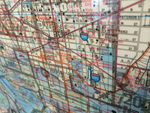Once known as the "gateway to New Mexico," Las Vegas, a pleasant town in the foothills of the Sangre de Cristo Mountains, was founded with a land grant from the Mexican government in 1835. A group of 29 Spanish colonists planted crops in the area and built a central plaza, which started out as a meeting place and a defense against Indian attack but soon became a main trading center on the Santa Fe Trail. Las Vegas boomed with the advent of the Atchison, Topeka, and Santa Fe Railway in 1879; almost overnight the town became the most important trading center and gathering place in the state and one of the largest towns in the Rocky Mountain West, rivaling Denver, Tucson, and El Paso in size.
Town settlers who arrived by train in the late 19th century shunned the indigenous adobe architecture, favoring instead building styles more typical of the Midwest or New England. They put up scores of fancy Queen Anne- and Victorian-style houses and hotels, and the town is noted to this day for its dazzling diversity of architectural styles. Some 900 buildings in Las Vegas are on the National Register of Historic Places.
Meanwhile, the town saw visits from many notable characters, including Billy the Kid, Wyatt Earp, and Doc Holliday (who practiced dentistry here). It continues to play its Old West part in movies: Scenes from Wyatt Earp, The HiLo Country, and All the Pretty Horses were shot here, as were Tom Mix's vintage westerns. Strolling the streets, you'll get a sense of those past times as you peruse Western wear shops, bookstores, and old soda fountains that seem caught in a time warp, with their period architecture and friendly business owners.








